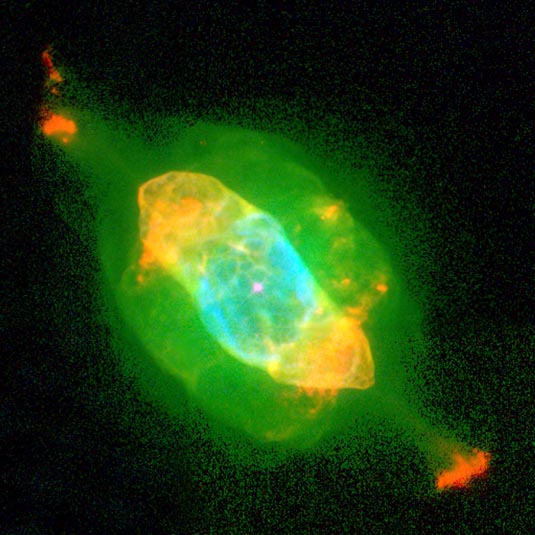
Planetary nebula
RA 21h 04m 10.9s Dec -11° 21' 48
Aquarius
Estimated 1400-5200 light years
8.0
41"× 35"
0.4 to 0.8 light years
2.5 to 1
NASA, Bruce Balick (U of Washington), Jason Alexander (U of Washington), Arsen Hajian (U.S. Naval Observatory), Yervant Terzian (Cornell University), Mario Perinotto (U of Florence, Italy), Patrizio Patriarchi (Arcetri Observatory, Italy)
December 17, 1997
2017 Image: N1731
ABOUT THIS IMAGE:
NGC 7009 has a bright central star at the center of a dark cavity bounded by a football-shaped rim of dense, blue and red gas. The cavity and its rim are trapped inside smoothly-distributed greenish material in the shape of a barrel and comprised of the star's former outer layers. At larger distances, and lying along the long axis of the nebula, a pair of red "ansae", or "handles" appears. Each ansa is joined to the tips of the cavity by a long greenish jet of material. The handles are clouds of low-density gas. NGC 7009 is 1,400 light-years away in the constellation Aquarius. The Hubble telescope observation was taken April 28, 1996 by the Wide Field and Planetary Camera 2
From Wikipedia:
The Saturn Nebula (also known as NGC 7009 or Caldwell 55) is a planetary nebula in the constellation Aquarius. It appears as a greenish-yellowish hue in a small amateur telescope. It was discovered by William Herschel on September 7, 1782, using a telescope of his own design in the garden at his home in Datchet, England, and was one of his earliest discoveries in his sky survey. The nebula was originally a low-mass star that ejected it's layers into space, forming the nebula. The central star is now a bright white dwarf star of apparent magnitude 11.5. The Saturn Nebula gets its name from its superficial resemblance to the planet Saturn with its rings nearly edge-on to the observer. It was so named by Lord Rosse in the 1840s, when telescopes had improved to the point that its Saturn-like shape could be discerned. William Henry Smyth said that the Saturn Nebula is one of Struve's nine "Rare Celestial Objects."
The
Saturn Nebula is a complex planetary nebula and contains many morphological
and kinematic sub-systems in three dimensions. It includes a halo, jet-like
streams, multiple shells, ansae ("handles"), and small-scale
filaments and knots. The ansae are expanding non-radially from the central
star.
The distance of the Saturn Nebula is not known precisely because no reference
stars have been detected in its neighborhood that could be used to accurately
gauge it. Therefore any distance given is somewhat suspect. Sabbadin et
al. 2004 estimates the distance to be 5,200 light-years (1.6 kpc). In
1963 O'Dell estimated it to be 3,900 light-years (1.2 kpc), which gives
an approximate diameter of 0.5 light years for the object as a whole.
The central star, a very hot bluish dwarf with a temperature of 55,000 K, from which the nebula is believed to originate, has an absolute magnitude of +1.5, which equates to a luminosity of about 20 Suns and a visual magnitude of 11.5. This strong ultraviolet irradiation from the central star is believed to create the characteristic fluorescent green tint of the nebula via the radiation of doubly ionized oxygen. The object overall has a visual magnitude of 8 and a radial velocity of 28 miles per second in approach.
The
nebula can be spotted 1 degree west of the star Nu Aquarii. The central
portion measures 25" x 17", while the outer shell extends to
41"× 35". It is a beautiful object with a high surface
brightness.